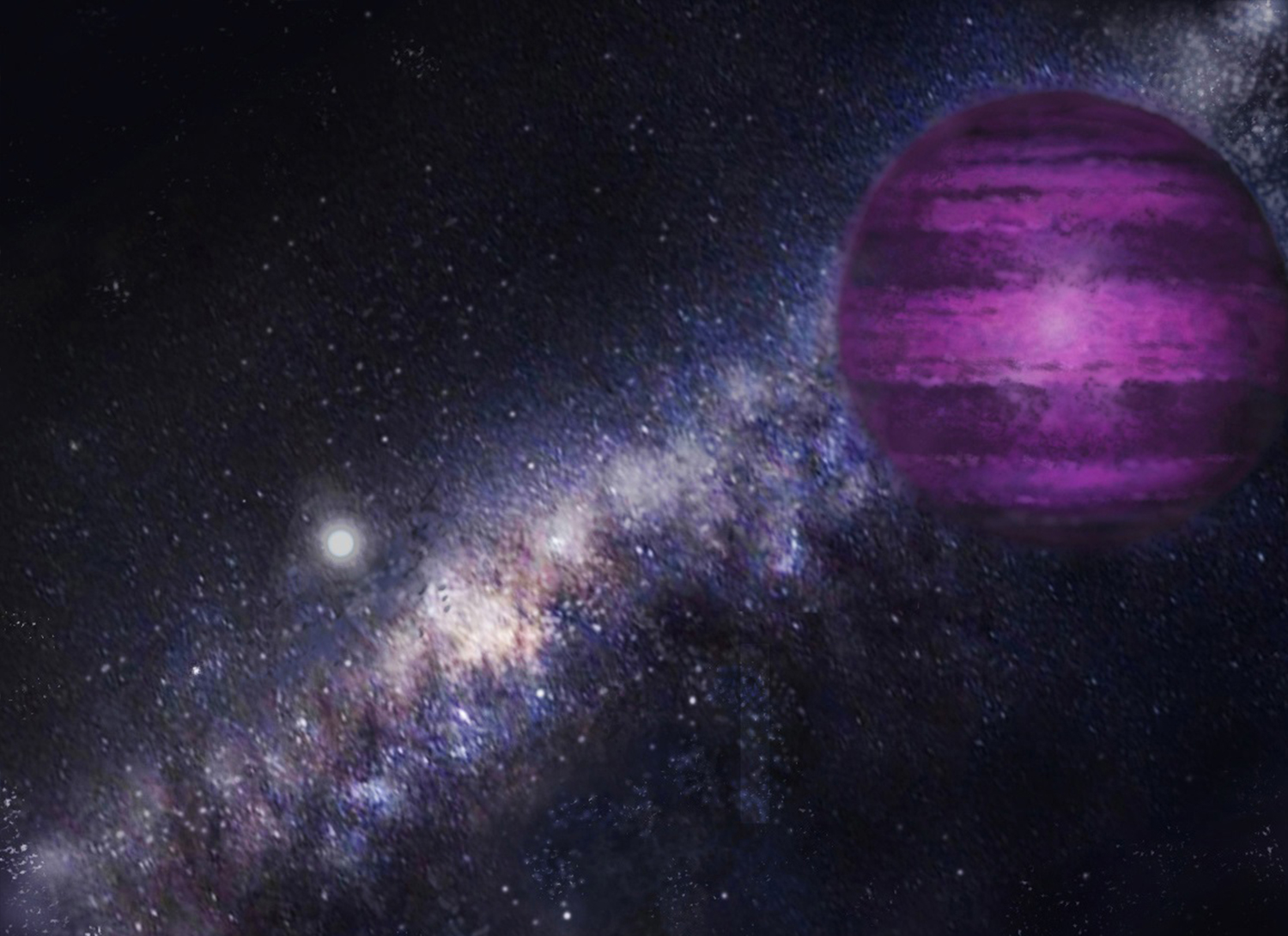Astrophysicists Locate 100 New Sunny Neighbors with Citizens’ Help

Artist rendering depicting one of this study’s superlative discoveries, the oldest known, wide-separation white dwarf plus cold brown dwarf pair. The small white orb represents the white dwarf (a remnant of a long-dead sun-like star), while the purple foreground object is the freshly discovered brown dwarf companion. This companion was previously unknown–until it was spotted by citizen scientists–because it lies in direction of the Milky Way, shown as a dense band of background stars. The NIRES instrument at the W. M. Keck Observatory provided spectroscopic confirmation of the cold brown dwarf. Credit: William Pendrill (paper co-author and Backyard Worlds citizen scientist)
The sun’s neighborhood just got a little more crowded. A new discovery by the Backyard Worlds team of citizen scientists and international astrophysicists, including researchers from UC San Diego, shows that about 100 cool brown dwarfs, never before observed, are in residence in the solar community. This treasure trove of discoveries has also uncovered a missing link within the local brown dwarf population. The findings will be published in the August 20, 2020 issue of The Astrophysical Journal and are available in preprint format on arXiv.org.
Brown dwarfs are celestial objects that are categorized between the most massive planets and the smallest stars. Lacking the mass to sustain nuclear reactions at their core, brown dwarfs are sometimes referred to as “failed stars,” or, because of their cool atmospheres and planet-sized diameters, “super Jupiters.” The small sizes and low temperatures of these objects make them extremely faint, so searches for the very coldest brown dwarfs focus on the immediate neighborhood of the sun, otherwise they would be too distant to detect. Discovering and characterizing these astronomical neighbors is fundamental to understanding the history of the universe and our place in it.
“These free-floating new worlds offer the opportunity for insights into the formation and atmospheres of planets beyond the solar system,” said Aaron Meisner, lead author of the paper and assistant scientist at the National Science Foundation’s (NSF) NOIRLab’s Astro Data Lab facility. “This collection of cold brown dwarfs also allows us to accurately estimate the number of free-floating planets roaming interstellar space near the sun.”
UC San Diego’s Professor of Physics Adam Burgasser and researchers from the Cool Star Lab contributed to the breakthrough discovery. The Cool Star Lab team used the sensitive Near-Infrared Echellette Spectrometer, or NIRES, instrument on the 10-meter W. M. Keck Observatory on Maunakea, Hawaii, to identify several of the faintest and coolest of the newly discovered brown dwarfs.
“We used NIRES to measure the near-infrared spectra of these sources,” said Burgasser, “which allows us to measure the temperature and gases present in their atmospheres. Each spectrum is essentially a fingerprint that allows us to distinguish a cool brown dwarf from other kinds of stars.”
To help find our sun’s coldest, nearest neighbors, the astronomers of the Backyard Worlds project turned to a worldwide network of more than 100,000 citizen scientists. These volunteers diligently inspect trillions of pixels of telescope images to identify the subtle movements of nearby brown dwarfs and planets. Despite the advances of machine learning and supercomputers, there’s still no substitute for the human eye when it comes to finding faint, moving objects.
Backyard Worlds volunteers have already discovered more than 1,500 stars and brown dwarfs near the sun—this new discovery represents about 100 of the coldest in that sample. According to Meisner, this is a record for any citizen science astronomy program, and 20 of the citizen scientists are listed as co-authors of the study. A handful of these cool worlds—which are among the coldest brown dwarfs known—approximate the temperature of Earth, based on measurements made by the recently decommissioned Spitzer Space Telescope.
This three-dimensional rendering highlights the trove of cold, nearby brown dwarfs discovered by citizen scientists participating in the Backyard Worlds: Planet 9 project. The sun is at the center, and each brown dwarf appears as a colorful orb at its current location in space. Redder colors correspond to colder temperatures, with the innermost shell of deep red (extremely cold) discoveries representing the hundred newly published worlds. The green grid is aligned with the plane of the Milky Way, with squares spaced at intervals of 5 parsecs (roughly 15 light years). Over the course of many millions of years, these objects found near the sun will disperse throughout the Milky Way. Credit: Jonathan Gagne (University of Montreal) and Jacqueline Faherty (American Museum of Natural History)
“This paper is evidence that…
Read More: Astrophysicists Locate 100 New Sunny Neighbors with Citizens’ Help

